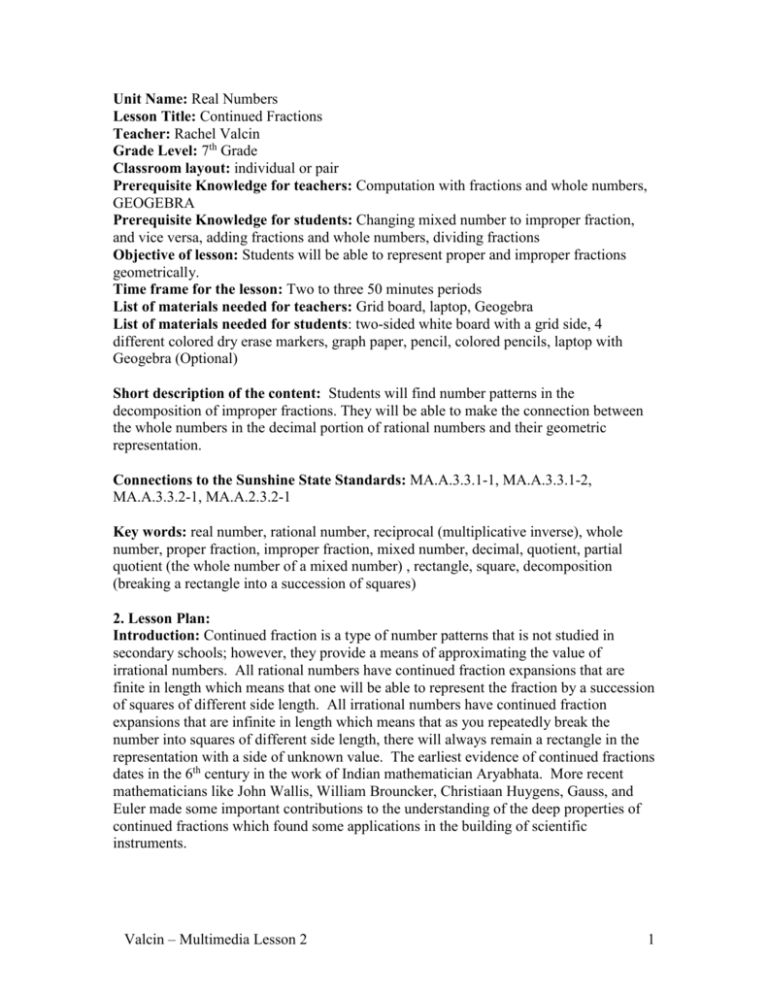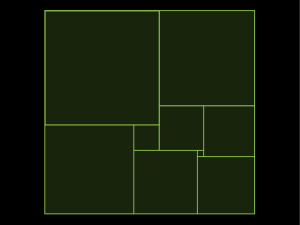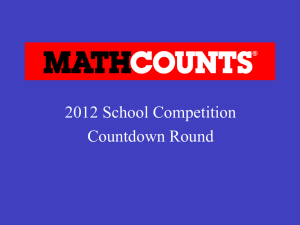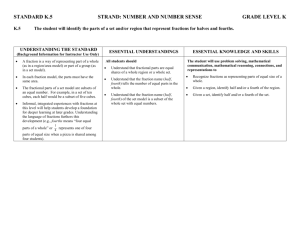valcinmultimedialesson2 - It works!
advertisement

Unit Name: Real Numbers Lesson Title: Continued Fractions Teacher: Rachel Valcin Grade Level: 7th Grade Classroom layout: individual or pair Prerequisite Knowledge for teachers: Computation with fractions and whole numbers, GEOGEBRA Prerequisite Knowledge for students: Changing mixed number to improper fraction, and vice versa, adding fractions and whole numbers, dividing fractions Objective of lesson: Students will be able to represent proper and improper fractions geometrically. Time frame for the lesson: Two to three 50 minutes periods List of materials needed for teachers: Grid board, laptop, Geogebra List of materials needed for students: two-sided white board with a grid side, 4 different colored dry erase markers, graph paper, pencil, colored pencils, laptop with Geogebra (Optional) Short description of the content: Students will find number patterns in the decomposition of improper fractions. They will be able to make the connection between the whole numbers in the decimal portion of rational numbers and their geometric representation. Connections to the Sunshine State Standards: MA.A.3.3.1-1, MA.A.3.3.1-2, MA.A.3.3.2-1, MA.A.2.3.2-1 Key words: real number, rational number, reciprocal (multiplicative inverse), whole number, proper fraction, improper fraction, mixed number, decimal, quotient, partial quotient (the whole number of a mixed number) , rectangle, square, decomposition (breaking a rectangle into a succession of squares) 2. Lesson Plan: Introduction: Continued fraction is a type of number patterns that is not studied in secondary schools; however, they provide a means of approximating the value of irrational numbers. All rational numbers have continued fraction expansions that are finite in length which means that one will be able to represent the fraction by a succession of squares of different side length. All irrational numbers have continued fraction expansions that are infinite in length which means that as you repeatedly break the number into squares of different side length, there will always remain a rectangle in the representation with a side of unknown value. The earliest evidence of continued fractions dates in the 6th century in the work of Indian mathematician Aryabhata. More recent mathematicians like John Wallis, William Brouncker, Christiaan Huygens, Gauss, and Euler made some important contributions to the understanding of the deep properties of continued fractions which found some applications in the building of scientific instruments. Valcin – Multimedia Lesson 2 1 Explanation of the math involved: This lesson is intended to help students make the connection between their knowledge of number sense and geometry. They are investigating the decimal portion of numbers. So far their understanding has been limited to rote memorization of definition and steps to compute with fraction without any tangible representation of the process. At best, students can explain decimal portion of a number by using the place value system, but further than that, they have no clue how to find other number patterns. Sadly, most math teachers’ understanding of the number system does not go any further than what they had studied up to high school. Instructional methods: Teacher-centered approaches: This lesson should be taught as an extension of the unit on fractions after the students have had plenty of practice renaming fractions and mixed numbers, adding, and dividing fractions. The teacher will need to have discussion about the vocabulary words with an emphasis on partial quotient and decomposition which are not familiar terms at this level. Much of the delivery of instruction needs to involve teacher prompted questions that the class will answer at every step. Of course, the teacher will have to demonstrate the process from rectangle to squares and vice versa. Student-centered approaches: For the initial practice exercises, the examples that the teacher chooses should require 4 steps to complete each one. Students should be in cooperative groups of four where each one constructs a step in the continued fraction pattern using a different colored dry erase pen. This will ensure that each student participates and that the teacher can easily see what each member of the group has contributed. After they complete the construction, teacher would ask them to lift up their dry-erase board to ascertain if each one has contributed and if the construction is accurate. That is an informal way to assess understanding and provide quick feedback to the groups. After they practice 2-3 examples as a group, each student should practice 2-3 examples independently. Step-by-step procedure: a) As a lesson opener, the teacher should have a discussion with the students about the vocabulary words to ascertain mastery. At that point, s/he will start showing the connection between the number sense vocabulary as they relate to the geometry words. For example, an improper fraction such as 8/5 is represented geometrically by a rectangle where the length is 8 units and the width is 5 units; proper fraction 5/8 would be a rectangle with length of 5 units and width of 8 units. b) Teacher should build on this lesson by having a discussion with students about 1. what strategies they would use to break a big rectangle into squares of different sizes 2. what strategies they would use to start a construction with two or more small congruent squares to create a big rectangle Teachers can use Geogebra or any grid board to demonstrate this concept. (Sample examples) Valcin – Multimedia Lesson 2 2 Example for strategy 1 Step1- Initial rectangle 8x5, length is 8 units, width is 5 units Step 2. Decomposition of rectangle into squares Sorting the squares from biggest to least 1 brown 5x5, 1 green 3x3, 1 blue 2x2, 2 red 1x1 At this point the teacher should introduce the notation for decomposed fraction. Short hand notation for 8/5 = [1; 1, 1, 2]. The 1 followed by the semicolon refers to the brown square which refers to the whole number (partial quotient), the subsequent numbers (1, 1, 2) represent the proper fraction (decimal) part of the original fraction. The numbers following the semicolon list the number of additional squares from biggest to smallest: 1 (green), 1 (blue), 2 (red). (If the original fraction was a proper fraction like 5/8, then the shortcut would have been [0; 1, 1, 1, 2]. The rectangle showing the fraction geometrically would be the same as the one above, however its orientation would be 90 degrees clockwise. After students had enough practice breaking up a rectangle into as succession of squares, teacher needs to also show numerically how to arrive at the decomposition of an improper fraction. The process is to take the whole number (partial quotient) out the improper fraction and to rewrite the proper fraction as 1 over its reciprocal. The decomposition has reached its end when the denominator or numerator is 1. Going back to our example above, we rewrite our improper fraction as the sum of a whole number 8 3 3 and a proper fraction, 1 . Next we need to rewrite our proper fraction so that 5 5 5 Valcin – Multimedia Lesson 2 3 we can find another whole number. Thus, we rewrite which is 3 as 1 divided by its reciprocal 5 3 1 1 5 because they are equivalent. . We continue the same process 5 5 1 2 3 3 3 until our final decomposed fraction has 1 as numerator or denominator 2 1 1 . 3 3 1 1 2 2 8 1 Thus, 1 or [1; 1, 1, 2] 1 5 1 1 1 2 Example for strategy 2 Step 1 Valcin – Multimedia Lesson 2 Step 2 4 Step 3 Teacher should use the second strategy to represent how one can start with the smallest squares to arrive at the original rectangle (improper fraction). The goal of this activity is to come up with a rectangle at each stage of the construction. The procedure is to build the next size square on the longest side of the previous rectangle, the longest side will be represented by the denominator. Since the students have seen that we have three brown squares in step 1, they are going to be represented as 1/3; the denominator represents the longest side of the rectangle. Then in step 2 we constructed two congruent squares on the longest side of the rectangle in step 1. Thus the new rectangle can also be written as 1 3 3 1 7 . Then in step 3, we constructed 1 square on the longest side of the 3 3 3 3 3 rectangle in step 2. Thus the new rectangle can also be written as 2 3 7 3 10 which is our original rectangle whose dimensions are 10x7. 7 7 7 7 1 Another notation for continued fraction is using the fraction bar following the general formula where a0 is the number of biggest squares, a1 is the number of the next size squares and so for and so on. X= a0 1 a1 1 a2 1 a... 1 ... Referring to our previous example in strategy 2 step 3, we had the following squares from biggest to smallest: a0=1, a1=2, a2= 3; thus we can substitute those values in the above formula. Valcin – Multimedia Lesson 2 5 1 1 3 3 7 3 10 1 1 1 1 . Thus the original 1 2 31 7 7 7 7 7 7 2 3 3 3 rectangle with decomposition [1; 2, 3] had a length of 10 units and a width of 7 units. Do note that if the decomposition of the fraction is given using the fraction bars, in order to find the original fraction, one needs to start computing from the last step shown which is the last expression at the bottom. X= 1 1 1 c)Teacher will construct other rectangles starting with 2, 3 or more small congruent squares and adding on other squares whose side length is the longest side of the last rectangle in the construction (length of the last two squares constructed). Then she will have students sort the squares from smallest to biggest and record the number of squares found in each size. (To make it more interactive, teacher should ask students to how many squares should be added to the construction at each stage; give the a range of numbers to choose from so that the construction is not too big) d) Teacher will show notation of the squares in the construction using the short cut notation and the fraction bar representation. e) Teacher demonstrates how to break a rectangle into a succession of squares (two examples); she will have students count the squares found, starting from the biggest square(s) to the smallest one(s), and record how many squares of each size is found in the decomposition. f) Students group will be assigned two similar constructions to do. Key questions to be asked: How do I get the biggest square from a rectangle? How do I get the next size square? So forth and so on, until all the squares in the rectangle are accounted for. What is the side length of the next square? How long and how wide is the new rectangle now? 1. Description of class activities: The description of class activities is already addressed in the step-by-step procedures portion of the lesson. Closure to the lesson: At the closure of the lesson, teacher should informally quiz to students to find out it they understand the basic concepts of continued fraction. An example of [2; 1, 1, 3] Assignments for the students: Express the following improper fractions as continued fractions expansions. a) 17/7 b) 11/3 c) 25/16 Convert these continued fractions expansions into improper fractions. a) [2; 1, 1, 5] b) [1; 1, 2, 5] Valcin – Multimedia Lesson 2 6 c) [3; 1, 1, 2] Assessments For exercises 1 and 2, construct a rectangle using your grid paper or (GEOGEBRA), show its decomposition graphically by showing its succession of squares starting from the largest size to the smallest. Write the continued fraction expansion using the fraction bar and the short cut (brackets). 1. 9x5 2.17x6 For exercises 3 and 4, find the improper fraction with the expansions given below. Then draw the rectangle showing the squares that made up the expansion. 2. [2; 1, 2, 1, 3] 3. [1; 1, 1, 5] Plan for providing feedback to the students after assessment Before the teacher goes over the answers to the assessments, students should go back to their cooperative groups to compare and discuss their answers. It is less threatening for students Answer keys to assignments and assessments. Assignments for the students key: Express the following as continued fractions a) 17/7= [2; 2, 3] b) 11/3= [3; 1, 2] c) 25/16 = [1; 1, 1, 3, 2] Convert these continued fractions expansions into improper fractions. d) [2; 1, 1, 5]=17/11 e) [1; 1, 2, 5] = 27/16 f) [3; 1, 1, 2] = 18/5 Assessments key For exercises 1 and 2, construct a rectangle using your grid paper or (GEOGEBRA), show its decomposition graphically by showing its succession of squares starting from the largest size to the smallest. Write the continued fraction expansion using the fraction bar and the short cut (brackets). 1. 9x5 Valcin – Multimedia Lesson 2 7 9 1 1 or [1; 1, 4] 1 5 1 4 2.17x6 17 1 2 or [2; 1, 5] 1 6 1 5 For exercises 3 and 4, find the improper fraction with the expansions given below. Then draw the rectangle showing the squares that made up the expansion. 4. [2; 1, 2, 1, 3] 1 26 X= 2 1 11 1 1 2 1 1 3 Valcin – Multimedia Lesson 2 8 5. [1; 1, 1, 5] 1 X= 1 1 1 1 17 11 1 5 Valcin – Multimedia Lesson 2 9 Supplemental activities lesson Each student needs to write two continued fractions expansions with 5 terms using the short cut method. Next write the continued fractions expansions using the fraction bar. Then draw the rectangle representing the expansion showing the succession of squares that make it up. Connections section This lesson could also be used to represent irrational numbers. However, it seems wise to limit the student assignments to fractions. Teacher could show the decomposition of an irrational number just for the purpose of demonstration. Instructional Materials The instructional materials consist of Geogebra and Word Tools used to create the instructional materials are Geogebra and Word (Hotpotatoes Optional). http://www.mcs.surrey.ac.uk/Personal/R.Knott/Fibonacci/cfINTRO.html#notn http://en.wikipedia.org/wiki/Continued_fraction Valcin – Multimedia Lesson 2 10







